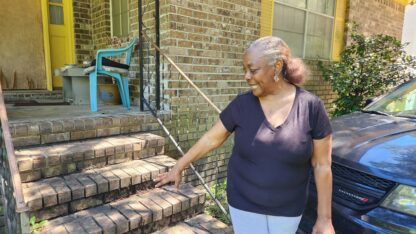This coverage is made possible through a partnership between WABE and Grist, a nonprofit environmental media organization.
Last week, a Georgia road crew hauled away a large pile of dirt heaped on a road that goes from Statesboro to Metter. It was a makeshift roadblock to keep people from crossing a nearby bridge that was flooded during Tropical Storm Debby.
“We done this because people have been running the barricades,” explained Dink Butler, the public works director for Bulloch County, about 50 miles northwest of Savannah.
Heavy rainfall from Debby overflowed stream banks, burst through dams and washed away dirt roads throughout the county. Even last week, as the flooding receded and roads began to reopen, some neighborhoods remained stranded by water.
“Especially along the rivers, the dead end roads that go into the river. We’re addressing the limited access, or the no access locations,” Butler said. “We’re prioritizing those so that we’ll be able to get emergency services to them if they need it.”
To do this, the county hauled in rock to fully rebuild some roads even as the floodwater remained. Beyond emergency repairs, the county has a long recovery ahead. Bulloch County has around 700 miles of dirt roads — the most in the state, Butler said — and the storm washed away many of them.
“We probably lost an average of a foot of dirt across most of these roads,” he said.
Like many of the areas hit hardest by Tropical Storm Debby, Bulloch is pretty far inland.
This isn’t the first time a tropical storm has hit inland Georgia in recent years. And with climate change supercharging storms, it likely won’t be the last.
The storm’s path has a lot to do with the location of its impacts: Debby came from the Gulf of Mexico, across Florida and into South Georgia, rather than traveling up the Atlantic coast.
But Debby also caused those heavy inland impacts because it moved slowly while dumping a lot of rain.
According to University of Georgia meteorologist Marshall Shepherd, storms like that are getting more common. And while it’s too soon to calculate the exact effect climate change had on this particular storm, the intense rainfall fits the overall trend.
“We know that climate change is juicing precipitating systems in general,” said Shepherd. “The data has been very clear that when it rains, it rains with greater intensity, even in just sort of heavy afternoon thunderstorms, not just hurricanes.”
That’s because a warmer atmosphere increases evaporation rates, making more water vapor in the air to create more rain.
In the case of hurricanes and tropical storms, the warming surface of the ocean adds fuel as well, meaning stronger winds and heavier rain. Tropical storms like Debby typically lose strength as they move over land.
But if they’re stronger when they make landfall, Shepherd said, that means they’re still plenty strong when they reach a place like Bulloch County.
“As these storms are more juiced and as they’re stronger, I think, impacts further inland will be significant,” he said.
That’s part of what happened with Hurricane Michael in 2018 and Hurricane Idalia last year, both of which came from the Gulf of Mexico but stayed strong enough across South Georgia to carve devastating paths.
Tropical Storm Debby also moved slowly, lingering over Southeast Georgia and continuing to dump rain instead of moving away. Some scientists contend that could be linked to climate change as well, though it’s not a conclusive finding, Shepherd said.
“There is some scholarship that suggests, research that suggests that climate change is causing storms to stall or slow down like we saw with Debby,” he said. “It’s plausible, I will say, but I think the jury is still a little bit out.”
Shepherd said slow movement has amplified the impacts of other recent storms, notably Hurricane Harvey in coastal Texas and Hurricane Dorian in the Bahamas.
Officials in Georgia are trying to adjust to this new reality of hurricane impacts outside typical coastal areas.
“With this one being different, we will put this in our plan, our statewide plan, and looking at the future, if we have another event like this, what’s our best course of action,” said Georgia Department of Transportation Southeast spokesperson Jill Nagel.
And local leaders are doing the same.
Valdosta, near the Florida border but far from the coast, fared far better in Debby than when Idalia tore through last year. In fact, the city was able to send personnel and sandbags to neighboring areas – something they were ready to do because of the recent storm impacts, according to Mayor Scott James Matheson.
“We’re storm hardened,” he said. “We are not feeling very good. We want that pattern to change.”
In Tattnall County, around 60 miles from the coast, the floodwater from Debby overwhelmed a three-foot culvert, washing out the roads approaching a bridge. As they rebuild, Nagel said, the county wants to expand the culvert so that it can handle more water.
In Bulloch County, Dink Butler said they’d like to do the same – but it can be expensive.
“If there is any reimbursement, we get reimbursements for replacement as-is,” he explained. “Any upgrades would be on us as far as any difference in expenses.”
Georgia has yet to declare a federal disaster, so counties may not even get reimbursed for replacing damaged infrastructure, let alone funding to improve it. Butler said the county will be researching financing and grant opportunities in hopes of better surviving the next storm.
In the meantime, he said, county officials are keeping an eye on the forecast. Hurricane season continues through November, meaning more storms may be on the way even as communities rebuild.
“I think there’s a lot of lessons to learn from this storm,” Butler said. “I just hope that we don’t have to face using them again no time soon.”
WABE environment reporter Marisa Mecke contributed to this story.









